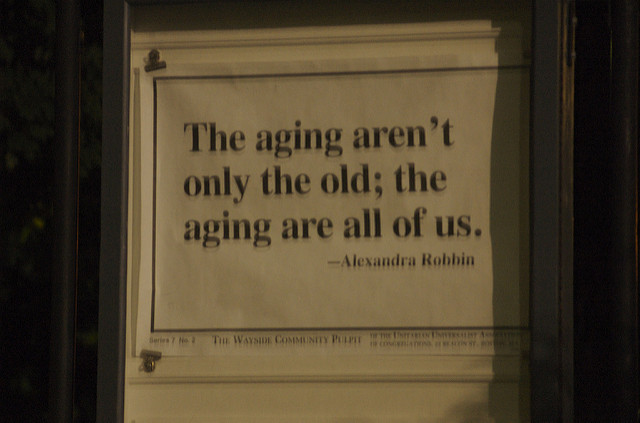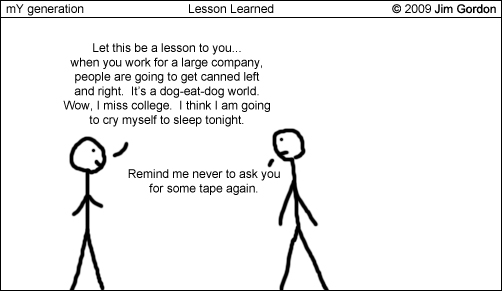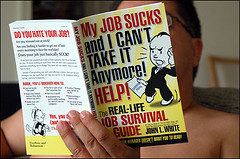|
|
|
Monday, January 13th, 2020

Poking through 14+ years of posts I find information that’s as useful now as when it was written.
Golden Oldies is a collection of the most relevant and timeless posts during that time.
This post dates to 2006, yet it is as applicable today as it was then. More, in fact, as a result of social media. In many ways social media is emotional contagion on steroids — nothing short of a pandemic.
Read other Golden Oldies here.
We’ve all heard, in one variation or another, of the ongoing battle between positive and negative that is fought within each person. One of the best versions is credited to the Cherokee and uses wolves to represent the opposing sides. I like this one because it recognizes that there may seem to be no difference in appearance (in other words, you can’t always tell a book by the cover) and goes on to say that the wolf that wins the battle will be the wolf that is fed.
Skipping the biggies (kill, lie, cheat, steal), just what impact does the battle have within the workplace? And what, as a manager, is your responsibility?
A lot, as it turns out—and it even has a name. It’s called “emotional contagion” and much of the recent research that’s been done has focused on emotionally negative or positive bosses. The results won’t surprise those of us who’ve been exposed to “glass half empty” people—the experts have proved that negative emotions, especially in leaders, can bring a group down faster than running air conditioning during flu season.
What can you do? Start by staying aware of your own mood. It’s hard to be upbeat when you walk out of a meeting with an enraged client, or a design review for a project about to go over budget, but if you don’t, you’ll bring down the rest of your team and that’ll blow off the entire day (or week or even longer).
Overcome your mood using a simple approach that I first learned from a book by Napoleon Hill more years ago than matters. He said, “Think, act, walk and talk like the person you want to become and you’ll become that person.” He also said, “Act enthusiastic and you’ll become enthusiastic” Put them together and you have an unbeatable, simple, solution for keeping your own morale and, as a result, the morale of your team, positive and productive.
And what about your people? You need to deal with any kind of negativity, including a “blue” mood, immediately. Talk to the person privately; you can’t force someone to discuss a problem, but you can offer your help. You also need to make it clear that whatever is going on you can’t allow it to bring down the team—that while at work he needs to present a positive front. If it’s a personal life problem, especially a big one (illness, loss of life, etc.) offer your support and find out how much of the situation you’re allowed to share with the team. Remember, with personal information, sharing is the employee’s call, not yours.
Sometimes, when really bad stuff happens, it’s hard to act, let alone, be positive, but it’s easier on the team if they understand, even generally, the situation and can be supportive. Also, remember that you aren’t, and shouldn’t be, either shrink or confidante, but you can help them find and connect with resources that offer support and solutions.
Sure, these approaches may seem simplistic, but oft times simple is best. After all, you’re not trying to solve the cause, but to mitigate the effect.
Image credit: thomas stein
Posted in Culture, Golden Oldies | No Comments »
Tuesday, December 4th, 2018

In case you hadn’t noticed the fertility rate is dropping, the world’s population is aging and it’s happening in a way that will forever change the workplace.
Back in 2010, Standard & Poor’s predicted that the biggest influence on “the future of national economic health, public finances, and policymaking” will be “the irreversible rate at which the world’s population is aging.”
As usual, our governments at all levels are doing little more than funding studies, wringing their hands and making dire predictions. In all likelihood they will continue doing more of the same, since constructive efforts would require bipartisan cooperation, and politicians aren’t known for their willingness to bite unpopular bullets — as our country’s aging/decrepit infrastructure proves.
Companies, by contrast, are uniquely positioned to change practices and attitudes now. Transformation won’t be easy, but companies that move past today’s preconceptions about older employees and respond and adapt to changing demographics will realize significant dividends, generating new possibilities for financial return and enhancing the lives of their employees and customers.
Companies might be in a better positioned, but rampant cognitive bias, whether unconscious or conscious, often prevails, resulting in a preference for hiring “people like me.”
Soon, the workforce will include people from as many as five generations ranging in age from teenagers to 80-somethings.
Are companies prepared? The short answer is “no.” Aging will affect every aspect of business operations — whether it’s talent recruitment, the structure of compensation and benefits, the development of products and services, how innovation is unlocked, how offices and factories are designed, and even how work is structured — but for some reason, the message just hasn’t gotten through.
So forget companies.
Current bosses, as well as bosses-to-be, have the great advantage of being able to do it now themselves, rather than waiting for their companies to act.
And it’s to their advantage, assuming they want to keeping their teams humming, well-staffed and highly productive.
But, depending on your MAP (mindset, attitude, philosophy™), don’t expect it to happen overnight or minimize the amount of work that may be required.
To get started, click the link at the link. It will take you to a seven part series in the Harvard Business Review called The Aging Workforce. It’s probably the fastest way to wrap your mind around what’s happening in all its complexity — or at least a lot of it.
And join me tomorrow for a closer look at cognitive bias, which affects the entire human race — including you and me.
Image credit: Justin Henry
Posted in Culture, Hiring, Personal Growth, Retention | No Comments »
Tuesday, May 16th, 2017

The “cult of me” isn’t new.
Through time, all generations were self-absorbed, but due to sheer size, the Boomers are the original me generation.
Gen X wasn’t much better and in 1982 Steve Wozniak financed The US Festival. According to Glenn Aveni, director of a recently released documentary about the festival,
“Woz felt the 1970’s were The ‘Me’ Generation and that it was time for the world to embrace a less selfish credo, one of unity and togetherness.”
Great music, but little effect.
Millennials come next, slightly more of them (75.4 M to 74.9) and most happily carry on the focus on me.
Tech has driven that focus across all generations via selfies and social media to the point that for millions their experiences, meals and even their lives exist only if they constantly post them online and they are liked, shared, and retweeted.
There was a time when I allowed myself to be more than what could fit onto a 2-by-4-inch screen. When I wasn’t so self-conscious about how I was seen. When I embraced my contradictions and desires with less fear of embarrassment or rejection.
The focus on me has led to a focus on being happy — polls and articles measuring happiness, and comparing happiness.
Back in the day, the Boomers considered everything a challenge that must be overcome. Fast forward to now and Millennials, especially those in Silicon Valley, see the world as a series of problems to be “hacked” (modern times call for modern words).
Which, to put it politely, is a crock.
Andrew Taggart thinks most of this is nonsense. A PhD in philosophy, Taggart practices the art of gadfly-for-hire. He disabuses founders, executives, and others in Silicon Valley of the notion that life is a problem to be solved, and happiness awaits those who do it. Indeed, Taggart argues that optimizing one’s life and business is actually a formula for misery.
This is important, because, in many ways, it’s Silicon Valley that is shaping much of our world — even for those of us who choose not to actively participate.
But I doubt Taggart and his ilk will change that attitude or the obsessive focus on “my world.”
Scott Berkun, a former Microsoft manager and philosophy major who has written multiple business books on the subject, says philosophy’s lessons are lost on most in Silicon Valley. Many focus on aggrandizing the self, rather than pursuing a well-examined purpose. “If you put Socrates in a room during a pitch session, I think he’d be dismayed at so many young people investing their time in ways that do not make the world or themselves any better,” he said.
I never saw life as a challenge or a problem. I prefer a different mantra.
Life is a mystery to be lived — not a challenge/problem to be overcome.
It’s a happy way to live.
Image credit: Joanna Lee Osborn
Posted in Culture, Ducks In A Row, Personal Growth | No Comments »
Tuesday, July 12th, 2016

Stereotyping is stupid.
It’s stupid because you can’t generalize out the traits of a few to an entire group.
And the larger the group, the stupider the results of stereotyping.
However, the lure of lumping together a large, demographic group for selling purposes is catnip to marketers and also the media.
The problem was well illustrated over the last few years in the depiction of Generation Y — those worthless, entitled Millennials.
80 million of them.
That thinking will go a long way to screwing up your efforts to sell to, hire and manage them.
So think about it.
Don’t you find it a bit ridiculous that 80 million people all think and act identically?
People who come from totally different backgrounds.
Not to mention totally different states; what are the chances of people from California/Maine/Texas/Florida raising their kids so identically that they would think alike?
All 80 million, if you listen to the media.
Jessica Kriegel provides great insight and an in-depth look at the stupidity in her new book, Unfairly Labeled: How Your Workplace Can Benefit from Ditching Generational Stereotypes.
The more you look at generational stereotypes the stupider they become.
The more you buy into them the more money it costs you and your company.
Flickr image credit: Umberto Salvagnin
Posted in Ducks In A Row | No Comments »
Monday, March 14th, 2016
It’s amazing to me, but looking back over the last decade of writing I find posts that still impress, with information that is as useful now as when it was written. Golden Oldies is a collection of what I consider some of the best posts during that time.
Eight years have passed since I wrote this, but it still holds true. Gen Y is eight years older and its leading edge are already producing Gen Z, which will continue the disruption, make unimaginable demands on the workplace and eventually become the status quo. That’s just the nature of the beast. Read other Golden Oldies here
I love it. Another article focusing on what companies need to do to hire Gen X and Y—of course they’re a big chunk of the workforce and getting bigger—Gen Y alone is 80 million strong and will compose 44% of workers by 2020.
Not that I disagree with the comments, but that the focus is strictly on doing these things in order to lure younger employees because they demand it, when the same perks [listed at this link–Ed] will attract works of any age.
‘The move often is aimed at attracting the youngest members of the work force — Generations X and Y — who are more outspoken than their baby boomer predecessors about demanding a life outside the office, said Lynne Lancaster, co-author of When Generations Collide.’
 What people seem to forget is that the Boomers were plenty disrupting and more demanding than their parents—in fact, historically each generation has disrupted the status quo and demanded more than its predecessor in one way or another. What people seem to forget is that the Boomers were plenty disrupting and more demanding than their parents—in fact, historically each generation has disrupted the status quo and demanded more than its predecessor in one way or another.
Just as every generation has focused on various traits of the upcoming generation and deemed them the end of civilization—if not the world.
I’m sure our hunter ancestors looked with horror at their gatherer children and predicted starvation if the herds weren’t followed.
I have no problem when Gen X and Y talk their demands and walk when they aren’t met because most of those demands will improve the workplace for all ages, but they would do well to remember that eventually they will become their parents—maybe not to themselves, but to the newer generations agitating for change.
Posted in Golden Oldies | No Comments »
Tuesday, February 3rd, 2015

Is your boss rigid? Or maybe it’s your colleagues — or even you?
Rigid in action, thought or imagination?
Rigidity is a mental habit and, although often grounded in ego, often has as much to do with the corporate culture as with the individuals involved.
Openness is based on trust and if the people or the culture don’t foster trust then you should expect them to be ultra turf conscious, not interested in sharing, and prone to spending large amounts of energy fighting every new thing that comes along.
Twenty-somethings often regard rigidity as synonymous with age, but that’s a wildly inaccurate assumption and not born out by the facts.
While the age thing may play on the surface, it should be recognized that rigidity is present in all ages.
There are a lot of pretty rigid twenty- and thirty-somethings and no one in their right mind ever called a teenager flexible
If you have any doubts about this, try getting your twenty-something co-workers to approach a subject from any position other than the one they advocate.
Rigidity is not so much about doing it differently as it is about doing it ‘my/our way’ and that attitude has substantially worsened.
It seems that everybody has a group and while their group is OK, other groups, i.e., any that don’t agree with theirs, are rigid, inflexible and standing in the way of progress.
In many ways rigidity is a form myopia.
The cure is simple to state, but difficult to implement, because it requires truly honest self-appraisal, which is not something with which most people are comfortable.
The thing to remember is that there’s value to be found in most approaches and when that value is tweaked and/or merged with other methods the result is usually worth far more than the original.
~~~~~~~~~~~~~~~~~~~~~~~~~~~~~~~~~
For additional input and insights to being a boss, be sure to check out the March Leadership Development Carnival.
Flickr image credit: trombone65
Posted in Ducks In A Row, Personal Growth | No Comments »
Thursday, April 10th, 2014

KG wrote a great post about ageism that started an interesting conversation regarding what needs to happen on both sides of the age line-in-the-sand for things to change.
But what people seem to forget is that, at the time, the Boomers were plenty disrupting and more demanding than their parents.
In fact, historically each generation has disrupted the status quo and demanded both more and different than its predecessor in one way or another.
Every generation has focused on various traits of the upcoming generation and deemed them the end of civilization—if not the world.
I’m sure our hunter ancestors looked with horror at their gatherer children and predicted starvation if the herds weren’t followed.
It’s a given that what’s currently happening always seems more difficult, and even brutal, than what happened in the past when viewed from a distance.
I have no problem when Gen Y demands and walks when those demands aren’t met for two reasons.
- Most of their demands are of universal interest (ability to make a difference, respect, challenge, opportunity to grow, etc.) and will improve the workplace for all ages; and
- walking is the privilege of the un’s—unmarried, unparenting, unmortaged, unencumbered.
One of the few constants is that we will always have a multigenerational workforce.
So everyone would do well to remember that eventually we all become our parents—maybe not in our own minds, but definitely in the minds of the newest generation agitating for change.
Flickr image credit: Eric Danley
Posted in Entrepreneurs, Personal Growth | No Comments »
Sunday, August 30th, 2009
See all mY generation posts here.

Posted in Culture, mY generation | No Comments »
Sunday, August 16th, 2009
See all mY generation posts here.

Posted in Culture, Leadership, mY generation | No Comments »
Monday, June 2nd, 2008
Image credit: candrews and Sarah and Nic
 Does the economic slowdown or whatever you want to call it really translate to a shortage of jobs or is something else going on? Does the economic slowdown or whatever you want to call it really translate to a shortage of jobs or is something else going on?
In the Northwest it seems that the problem isn’t jobs, it’s what people are willing to do.
“Steve Klein [general manager of Snohomish County PUD faces the stubborn problem getting young people to accept a job that starts at $55,000 a year… and journeyman’s wages of $72,000 a year. Last year 20 percent of the 15,000 or so workers in the utility industry were between the ages of 50 and 65, according to Employment Security.”
And it’s not just lineman,
“There’s so much work out there, we can’t get enough guys,” said ironworker John Lake. The prevailing wage in Snohomish County for journeyman ironworkers is $47.92 an hour nearly $100,000 a year although the work is seasonal.”
John Mohr, who runs the Port of Everett, “thinks the reason unions are struggling is a shift in the Northwest’s strong cultural tradition of organized labor. “A lot of people believe if you’re not working for Microsoft, you’re not part of the American success story.”
In the Midwest it’s more a case of jobs one place and people another.
“A survey of companies by Iowa Workforce Development, a state agency, found as many as 48,000 job vacancies, in industries including financial services… One estimate projects the job surplus to reach 198,000 by 2014, with vacancies increasingly in professional positions…”
“Iowa’s surplus arises from colliding trends: the exodus of young college graduates, a state economy that adds 2,000 jobs a month, low immigration and birth rates, and an image problem that makes it difficult to recruit workers from out of state.”
Is it really that the trades are “beneath” the Millennials? Does an un-hip location have to lead to a lack of skilled workers?
Does what’s happening in Iowa and Washington provide a look into the future as Boomers retire over the next ten years?
“Estimates of the national shortage run as high as 14 million skilled workers by 2020, according to widely cited projections by the labor economists Anthony P. Carnevale and Donna M. Desrochers.”
What do you think?
Posted in Business info, Compensation, Hiring | No Comments »
|
 Subscribe to
Subscribe to
MAPping Company Success
About Miki 
Clarify your exec summary, website, etc.
Have a quick question or just want to chat? Feel free to write or call me at 360.335.8054
The 12 Ingredients of a Fillable Req
CheatSheet for InterviewERS
CheatSheet for InterviewEEs™
Give your mind a rest. Here are 4 quick ways to get rid of kinks, break a logjam or juice your creativity!
Creative mousing
Bubblewrap!
Animal innovation
Brain teaser
The latest disaster is here at home; donate to the East Coast recovery efforts now!
Text REDCROSS to 90999 to make a $10 donation or call 00.733.2767. $10 really really does make a difference and you'll never miss it.
And always donate what you can whenever you can
The following accept cash and in-kind donations: Doctors Without Borders, UNICEF, Red Cross, World Food Program, Save the Children
*/
?>About Miki
About KG
Clarify your exec summary, website, marketing collateral, etc.
Have a question or just want to chat @ no cost? Feel free to write
Download useful assistance now.
Entrepreneurs face difficulties that are hard for most people to imagine, let alone understand. You can find anonymous help and connections that do understand at 7 cups of tea.
Crises never end.
$10 really does make a difference and you’ll never miss it,
while $10 a month has exponential power.
Always donate what you can whenever you can.
The following accept cash and in-kind donations:
|








 What people seem to forget is that the Boomers were plenty disrupting and more demanding than their parents—in fact, historically each generation has disrupted the status quo and demanded more than its predecessor in one way or another.
What people seem to forget is that the Boomers were plenty disrupting and more demanding than their parents—in fact, historically each generation has disrupted the status quo and demanded more than its predecessor in one way or another.



 Does the economic slowdown or whatever you want to call it really translate to a shortage of jobs or is something else going on?
Does the economic slowdown or whatever you want to call it really translate to a shortage of jobs or is something else going on?

